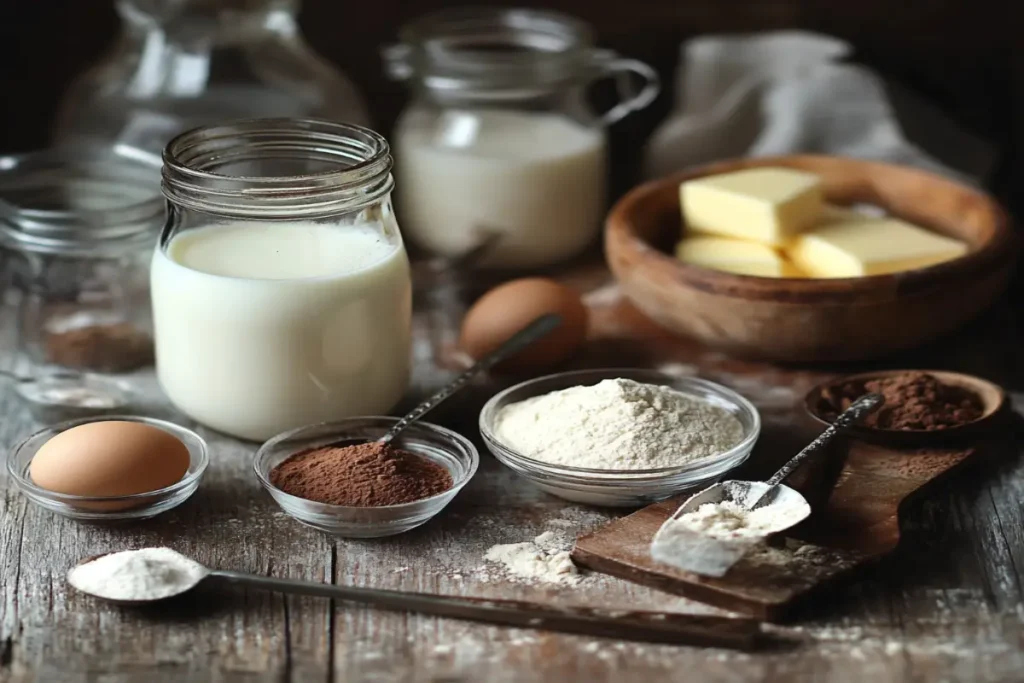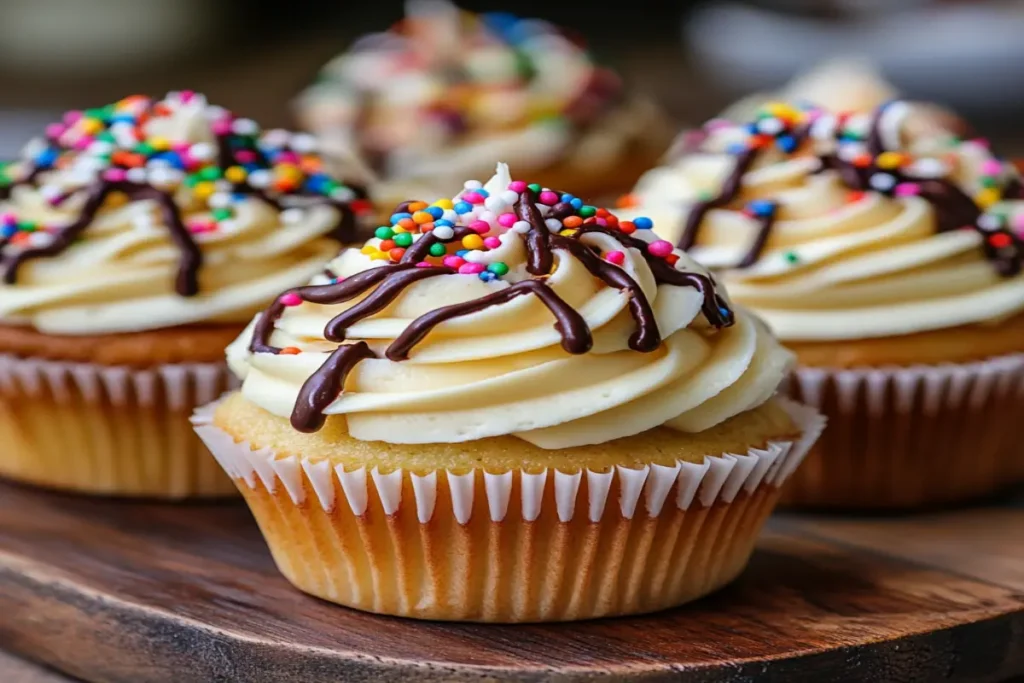Introduction
Are cupcakes better with milk or water? This common baking question often sparks curiosity among home bakers and professionals alike. The choice between these two liquids can significantly influence the outcome of your cupcakes, impacting everything from texture and flavor to moisture and appearance. Milk, with its natural fats and sugars, brings richness and tenderness to the batter, while water provides simplicity and hydration without additional flavors. Both options have their strengths, and the best choice often depends on the recipe, available ingredients, and personal preferences. Understanding how milk and water affect your cupcakes will empower you to make informed decisions and achieve the perfect bake every time. Whether you’re aiming for a rich, indulgent treat or a light, airy cupcake, exploring the role of these liquids will help you answer the question: Are cupcakes truly better with milk or water?
Table of contents
The Role of Milk in Baking Cupcakes
Milk plays a vital role in creating cupcakes that are both moist and flavorful. Its natural fats and proteins enhance the batter’s structure, resulting in a tender and rich crumb. Milk also acts as a hydrating agent, ensuring that dry ingredients combine seamlessly, creating a smooth and consistent batter. Additionally, the natural sugars in milk, such as lactose, subtly sweeten the cupcakes, complementing other flavors like chocolate or vanilla.
When it comes to the rise, milk interacts with leavening agents like baking powder or baking soda, helping cupcakes achieve a light and fluffy texture. Furthermore, milk contributes to even browning during baking, giving cupcakes a golden and appealing appearance. Choosing milk over water often elevates the overall quality of cupcakes, making them more indulgent and satisfying. For bakers seeking superior taste and texture, milk is a key ingredient worth incorporating into their recipes.
How Water Impacts Cupcake Texture and Taste
Water, though simpler than milk, plays an essential role in cupcake recipes by hydrating the dry ingredients and creating a cohesive batter. However, its lack of fats and proteins means water-based cupcakes tend to have a lighter, less rich texture. This absence of additional elements like lactose or creaminess results in a crumb that may feel less tender compared to milk-based cupcakes.
When it comes to flavor, water does not contribute any sweetness or depth, making the batter rely solely on other ingredients like sugar, vanilla, or cocoa for taste. Despite these limitations, water can still produce good cupcakes when paired with rich ingredients such as butter or oil, which add moisture and texture. Water is also an excellent choice for recipes catering to dietary restrictions or when milk is unavailable. While it lacks the richness of milk, water ensures flexibility and simplicity in baking.
Comparing Milk and Water for Cupcake Moisture
When comparing milk and water for cupcake moisture, milk emerges as the clear winner. The natural fats in milk provide additional richness and prevent dryness, ensuring that cupcakes remain moist even after cooling. Water, on the other hand, lacks these fats, making it more likely for cupcakes to dry out quickly. However, water can still work well if paired with oil or other moisture-retaining ingredients. Consider these key differences:
- Milk: Adds fats and proteins, resulting in a tender, moist texture.
- Water: Provides hydration but lacks richness, leading to a lighter crumb.
By understanding these distinctions, you can decide whether milk or water is better for cupcakes based on the desired outcome.
Why Milk Adds Flavor to Cupcakes
One reason cupcakes are better with milk is its ability to enhance flavor. Milk contains lactose, a natural sugar that adds subtle sweetness to baked goods. This sweetness complements other ingredients, such as chocolate or vanilla, creating a more balanced flavor profile. Furthermore, the fats in milk carry flavor compounds more effectively, intensifying the taste of the cupcakes. Using milk instead of water ensures a richer and more satisfying bite, making it the preferred choice for many bakers. Whether you’re making classic vanilla cupcakes or experimenting with unique flavors, milk’s contribution to taste cannot be overlooked.
Is Water a Suitable Substitute for Milk in Cupcakes?
While milk is often the first choice for cupcake recipes, water can be a suitable substitute in certain situations. Water is ideal for recipes that already include other rich ingredients, such as butter or oil, which compensate for the lack of fats in water. Additionally, water works well for dairy-free or vegan cupcake recipes when paired with plant-based fats. However, using water instead of milk may require adjustments to other ingredients to maintain moisture and flavor. For example:
- Add extra fat, like oil or margarine, to enhance texture.
- Use vanilla extract or spices to boost flavor.
By making these adjustments, you can ensure that water-based cupcakes still turn out delicious.
How Milk Enhances the Structure of Cupcakes
Milk contributes to the structure of cupcakes by interacting with proteins in the flour. This interaction creates a stable batter that holds its shape during baking. The fats in milk also coat the flour particles, resulting in a tender crumb. Additionally, milk’s ability to dissolve sugar and activate leavening agents ensures even distribution and consistent rising. Without milk, cupcakes may lack the structural integrity needed for a soft yet sturdy texture. For bakers aiming for perfectly shaped and fluffy cupcakes, using milk over water is often the best choice.
The Science Behind Using Water in Cupcake Recipes
The simplicity of water makes it a practical choice for many cupcake recipes. Water hydrates flour, allowing gluten to form and create structure in the batter. However, because water lacks the additional components found in milk, such as fats and proteins, it produces a different texture. Water-based cupcakes tend to be lighter and less rich, which can be beneficial for recipes that already include heavy or sweet ingredients. Understanding the science behind water’s role helps bakers use it effectively when milk is unavailable. By balancing other ingredients, you can still achieve excellent results with water-based cupcakes.
Best Practices for Choosing Between Milk or Water
When deciding between milk or water for cupcakes, consider these best practices:
- Flavor Profile: Use milk for richer, more flavorful cupcakes and water for lighter, simpler ones.
- Ingredient Balance: If the recipe already includes fats, water can work, but milk adds extra richness.
- Dietary Needs: Choose water for dairy-free or vegan recipes, and milk for traditional recipes.
- Occasion: Opt for milk in celebratory or indulgent recipes and water for everyday baking.
These considerations ensure you make the best choice based on your desired outcome and available ingredients.
Can You Combine Milk and Water in a Cupcake Recipe?
Yes, combining milk and water in a cupcake recipe can work well to balance richness and hydration. For example:
- Half Milk, Half Water: This approach adds some richness without being overly heavy.
- Adjust Other Ingredients: If using both, ensure the total liquid volume matches the recipe’s requirements.
This method provides flexibility, especially when milk is limited or you want a lighter texture while retaining some flavor.
How to Adjust Other Ingredients When Using Water

When using water instead of milk, it’s important to adjust other ingredients to maintain the cupcake’s quality. Consider these tips:
- Add Fats: Increase the amount of butter or oil to compensate for the lack of milk’s fats.
- Enhance Flavor: Use additional vanilla extract, spices, or cocoa powder for a richer taste.
- Monitor Baking Time: Water-based batters may bake slightly faster, so check for doneness earlier.
These adjustments ensure that your cupcakes remain moist and flavorful despite the substitution.
Why Many Bakers Prefer Milk Over Water for Cupcakes
Bakers often prefer milk over water because it enhances both flavor and texture. Milk’s natural fats and sugars contribute to a tender crumb and a more complex taste. Additionally, milk’s ability to interact with leavening agents results in a better rise and more consistent structure. Using milk also improves the cupcake’s appearance by promoting even browning. For bakers seeking a more indulgent and satisfying dessert, milk is the clear choice.
When to Use Water Instead of Milk in Cupcake Recipes
There are specific situations where water is a better choice than milk for cupcake recipes:
- Dairy-Free Baking: Water is essential for vegan or lactose-intolerant diets.
- Light Textures: Use water for airy, less rich cupcakes.
- Emergency Substitutions: When milk isn’t available, water works as a quick alternative.
Understanding these scenarios helps bakers make informed decisions and still achieve great results.
Frequently Asked Questions
1. Can I replace milk with water in any recipe? Yes, but adjust other ingredients like fats and flavors to compensate for the difference.
2. Does using milk make cupcakes sweeter? Milk adds natural sweetness due to lactose, enhancing the overall flavor.
3. Will water-based cupcakes rise as well as milk-based ones? They can, but milk’s interaction with leavening agents often produces a better rise.
4. Can I use plant-based milk instead of water? Yes, almond or oat milk works well as a substitute for added flavor and richness.
5. Does milk affect the baking time? Not significantly, but milk-based batters may brown more evenly.

Conclusion
Are cupcakes better with milk or water? The answer depends on your desired results and recipe requirements. Milk is often the preferred choice because it enhances the flavor and texture of cupcakes. The natural fats and sugars in milk contribute to a tender, moist crumb and a richer taste, making it ideal for indulgent desserts. Additionally, milk interacts with leavening agents to create a better rise and promotes even browning during baking. However, water remains a suitable alternative for lighter, simpler cupcakes or when catering to dietary restrictions. With a few adjustments to other ingredients, water can still produce delicious results. Ultimately, both milk and water have their place in baking. By understanding their roles, you can choose the right liquid for your recipe and achieve perfect cupcakes every time. Experimenting with both options will help you discover your personal preference.

